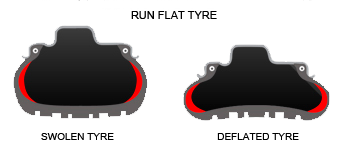
Anti-puncture tires are all those that, by means of different systems according to the manufacturer, allow a certain amount of kilometers to continue to roll at a moderate speed even if the inside pressure is zero. So they're known as run-flat
Thus, the first manufacturer to develop this type of tire was BRIDGESTONE in the late '80s for high-end sports vehicles. Later, each manufacturer would introduce its system:

- GOODYEAR in 1992 with the system EMT (Extended Mobility Technology).
- DUNLOP with the DSST (Dunlop Self Supporting Technology).
- CONTINENTAL with the SSR (Self Suppoting Runflat)
- MICHELIN with the SST (Self Supporting Tyre)
This system is based on a tire with no internal support ring called "self-carrying", but has reinforced flanks that guarantee load capacity in case of pressure-free shooting.
Another anti-puncture system is the so-called "stand-alone technology" in which an insert (ring, foam, etz) inside the tire makes it possible to run with no pressure without degrade the tire. With this system we have manufacturers:

- MICHELIN with the PAX SYSTEM on 1996
- CONTINENTAL with the CSR (Continental Safety Ring)
- PIRELLI with the EMI (Espanso Modulare Integrato)
 Recently, a third generation of anti-puncture tires has emerged in which the puncture is repaired in motion, i.e. when the tire detects a low pressure, a component in the interior is responsible for covering the hole immediately and the occupants are not aware of the puncture. Such is the system of: Recently, a third generation of anti-puncture tires has emerged in which the puncture is repaired in motion, i.e. when the tire detects a low pressure, a component in the interior is responsible for covering the hole immediately and the occupants are not aware of the puncture. Such is the system of:
- MICHELIN with the 3S CONCEPT
- PIRELLI with the system SEAL INSIDE
This system eliminates three inconveniences of others: the run-flat tire is heavier than the conventional tire, more expensive, and with the more rigid tread, the comfort of the vehicle is felt.
Apart from the anti-pinch tires, there are several systems to avoid having to stop to change the flat tire at the obvious risk of an accident. Manufacturers have opted to offer anti-puncture kits by filling the tires with self-sealing foam, and to connect a compressor installed on the site of the spare wheel.
Despite this, the future seems to go through removing the fifth wheel from the cars, whether conventional or "emergency cookie". This benefits both car designers, as one of the current problems is to insert the spare wheel into modern vehicles, as users with the savings in weight and therefore of fuel by eliminating about 30 kgs. being the most efficient cars. The logical deduction is that 20% of the tires required for passenger cars will be removed with the environmental benefit.
|